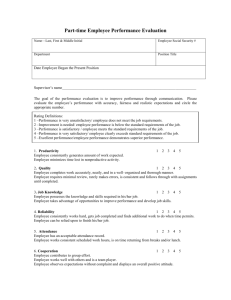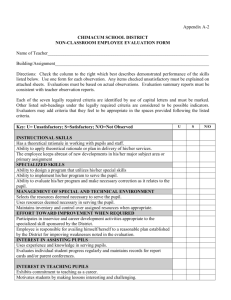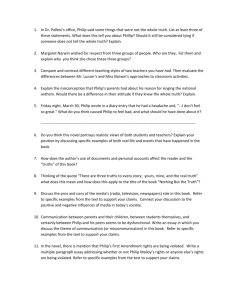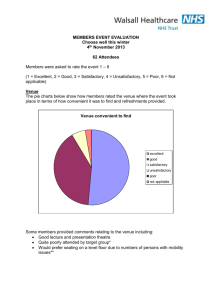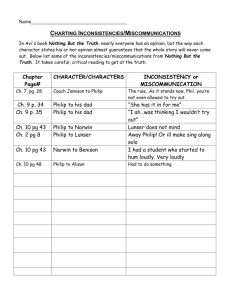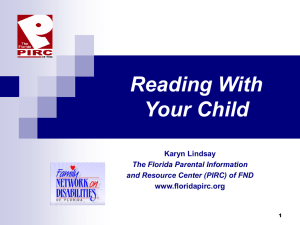AP Psychology - York County Schools
advertisement
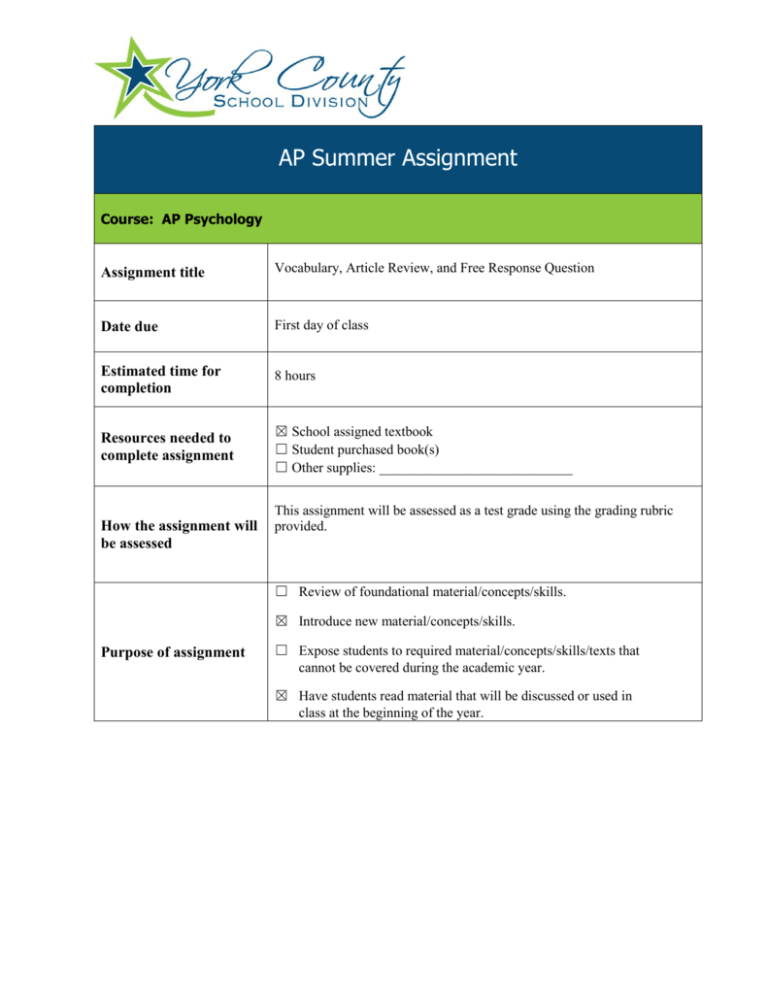
AP Summer Assignment Course: AP Psychology Assignment title Vocabulary, Article Review, and Free Response Question Date due First day of class Estimated time for completion 8 hours Resources needed to complete assignment ☒ School assigned textbook ☐ Student purchased book(s) ☐ Other supplies: ____________________________ How the assignment will be assessed This assignment will be assessed as a test grade using the grading rubric provided. ☐ Review of foundational material/concepts/skills. ☒ Introduce new material/concepts/skills. Purpose of assignment ☐ Expose students to required material/concepts/skills/texts that cannot be covered during the academic year. ☒ Have students read material that will be discussed or used in class at the beginning of the year. PART I: VOCABULARY Directions: Define and create notecards or a vocabulary list for the following vocabulary terms. Evaluate the definitions and group the terms together according to your understanding. Once you have defined the vocabulary terms, use your understanding of their definitions to group appropriate terms together and provide a brief rationale for your term groupings/associations. There should be a minimum of 4 groupings. These terms will be utilized during the first unit and will be included in your course assessments and on the AP Psychology Examination. Psychology Empiricism Structuralism Functionalism Applied Research Psychiatry Natural Selection Basic Research Nature versus Nurture Issue Biopsychosocial Approach Levels of Analysis Approaches to Psychology Biological Evolutionary Psychodynamic Behavioral Cognitive Humanistic Socio-cultural PART II: ARTICLE REVIEW AND GUIDED REVIEW QUESTIONS Directions: Students will read (3) of the seven articles on the theme of teens. After reading each article, students will analyze the article and complete four guided review questions. The questions must be answered in complete sentences for each of the three articles. The answers must be submitted on a separate piece of paper with the name of the journal, title of the article, author, and the publication date included at the top of the page. 1. New Insights on College Drinking (American Psychological Association, Oct. 2013) http://www.apa.org/monitor/2013/10/college-drinking.aspx 2. Partying on Facebook May Spur Teens’ Risky Behavior (Psych Central, Sept. 4, 2013) http://psychcentral.com/news/2013/09/04/partying-on-facebook-may-spur-teens-riskybehavior/59175.html 3. Why the Teen Brain is Drawn to Risk (Time, Oct. 8, 2012) http://www.cnn.com/2012/10/08/health/time-teen-brain-risk/index.html 4. Teens and Risky Behavior: More Complicated than it seems? (Los Angeles Times, Oct. 2, 2012) http://articles.latimes.com/2012/oct/02/news/la-heb-teens-risk-averse-20121001 5. What Makes Teens Tick (Time, May 10, 2004) http://www.time.com/time/magazine/article/0,9171,994126,00.html 6. Good Parents, Bad Results (U.S. News & World Report, June 12, 2008) http://health.usnews.com/health-news/family-health/living-well/articles/2008/06/12/goodparents-bad-results 7. Teenager, Friends, and Bad Decisions (New York Times, February 3, 2011) http://well.blogs.nytimes.com/2011/02/03/teenagers-friends-and-bad-decisions/ Guided Review Questions 1. What does the author attribute to risky/bad teenage behavior? Please explain your answer. 2. Does the author use research to support their claim about where risky/bad teenage behavior comes from? If so, describe the research? 3. Which of the 7 Psychological perspectives (Biological, Evolutionary, Psychodynamic, Behavioral, Cognitive, Humanistic, and Socio-Cultural) does this author use to present their case? Please explain your answer. 4. Do you agree with the author’s opinion about where risky/bad teenage behavior comes from? Explain why or why not. PART III: FREE RESPONSE QUESTION Directions: Read and answer the essay question. The application of a particular psychological perspective is similar to what you will experience on the AP exam. It is important to present a cogent (clear and organized) argument based on your critical analysis of the questions posed, using the appropriate psychological terminology. A rubric with scoring guidelines is provided. Philip, single, 25 years old, unemployed, had been hospitalized after a suicide attempt. Prior to the suicide attempt, Philip had run into an old girlfriend and her new boyfriend. They had a few drinks together before Philip, in a jealous rage stormed out of the restaurant. He began to think about how he could “pay her back.” Several years before this attempt he had felt frequently depressed for brief periods of time. He was especially critical of himself for his limited social life. He had never had a serious relationship because he became very critical of his girlfriends and demanded that they always meet his every need. During the past 3 years a psychiatrist had given him a drug that resulted in an unusual reaction requiring a hospital stay. Due to his hostile demands during his hospital stay he left the hospital against medical advice. Philip views his father as weak, ineffectual, and completely dominated by his (Philip’s) overbearing and cruel mother. He hates his mother with a passion he can barely control due to harsh name calling and abuse endured during childhood. He believes that his parents view him as lazy, irresponsible, and has a behavior problem. His parent state that Philip’s problem began when his brother was born (Philip was 10 years old). Philip doesn’t remember being difficult to discipline and states that his mother was once hospitalized for depression. As an adult Philip has had difficulty keeping a job and has had innumerable interactions with teachers, friends, employers in which he felt offended or unfairly treated. a. Define the seven perspectives/approaches to psychology. (Psychodynamic, Behavioral, Humanistic, Cognitive, Biological, Evolutionary, Socio-Cultural) b. Describe/explain Philip’s behavior from each of the perspectives. Give specific examples. Name:___________________________ AP Psychology Summer Assignment Grading Rubric Part I: Vocabulary (35 points) ALL 19 terms defined At least 4 groupings created Grouping rationales (all or none) Comments 19 points (1 point each) 4 points 12 points—Thorough rationales (above expectations) 8 points—Satisfactory rationales (meets expectations) 4 points—Unsatisfactory rationales (below expectations) Part II: Article Review & Guided Review Questions--Article #1 (17 points) On a separate sheet of paper Article title & author at top of page Guided Question #1 What does the author attribute to risky/bad teenage behavior? Explain your answer. 1 point 3 points—Thorough response Journal name at top of page Publication date at top of page 2 points—satisfactory response 1 point—unsatisfactory response Guided Question #2 Does the author use research to support their claim about where risky/bad teenage behavior comes from? If so, describe the research? 3 points—Thorough response 2 points—satisfactory response 1 point—unsatisfactory response Guided Question #3 Which of the 7 Psychological perspectives (Biological, Evolutionary, Psychodynamic, Behavioral, Cognitive, Humanistic, and SocioCultural) does this author use to present their case? Explain your answer. 3 points—Thorough response 2 points—satisfactory response 1 point—unsatisfactory response Guided Question #4 Do you agree with the author’s opinion about where risky/bad teenage behavior comes from? Explain why or why not. 3 points—Thorough response 2 points—satisfactory response 1 point—unsatisfactory response 2 points 1 point 1 point Article Review & Guided Review Questions--Article #2 (17 points) On a separate sheet of paper Article title & author at top of page Guided Question #1 What does the author attribute to risky/bad teenage behavior? Explain your answer. 1 point 3 points—Thorough response Journal name at top of page Publication date at top of page 2 points—satisfactory response 1 point—unsatisfactory response Guided Question #2 Does the author use research to support their claim about where risky/bad teenage behavior comes from? If so, describe the research? 3 points—Thorough response 2 points—satisfactory response 1 point—unsatisfactory response Guided Question #3 Which of the 7 Psychological perspectives (Biological, Evolutionary, Psychodynamic, Behavioral, Cognitive, Humanistic, and SocioCultural) does this author use to present their case? Explain your answer. 3 points—Thorough response 2 points—satisfactory response 1 point—unsatisfactory response Guided Question #4 Do you agree with the author’s opinion about where risky/bad teenage behavior comes from? Explain why or why not. 3 points—Thorough response 2 points—satisfactory response 1 point—unsatisfactory response 2 points 1 point 1 point Article Review & Guided Review Questions--Article #3 (17 points) On a separate sheet of paper Article title & author at top of page Guided Question #1 What does the author attribute to risky/bad teenage behavior? Explain your answer. 1 point 3 points—Thorough response Journal name at top of page Publication date at top of page 2 points—satisfactory response 1 point—unsatisfactory response Guided Question #2 Does the author use research to support their claim about where risky/bad teenage behavior comes from? If so, describe the research? 3 points—Thorough response 2 points—satisfactory response 1 point—unsatisfactory response Guided Question #3 Which of the 7 Psychological perspectives (Biological, Evolutionary, Psychodynamic, Behavioral, Cognitive, Humanistic, and SocioCultural) does this author use to present their case? Explain your answer. 3 points—Thorough response 2 points—satisfactory response 1 point—unsatisfactory response Guided Question #4 Do you agree with the author’s opinion about where risky/bad teenage behavior comes from? Explain why or why not. 3 points—Thorough response 2 points—satisfactory response 1 point—unsatisfactory response 2 points 1 point 1 point Part III: Scoring Rubric for Free Response Question (14 points) Correctly defined the Psychodynamic approach Correctly defined the Behavioral approach Correctly defined the Humanistic approach Correctly defined the Cognitive approach Correctly defined the Biological approach Correctly defined the Evolutionary approach Correctly defined the Socio-Cultural approach Completely described/explained Philip’s behavior with specific examples according to the Psychodynamic approach. Completely described/explained Philip’s behavior with specific examples according to the approach. Completely described/explained Philip’s behavior with specific examples according to the approach. Completely described/explained Philip’s behavior with specific examples according to the approach. Completely described/explained Philip’s behavior with specific examples according to the approach. Completely described/explained Philip’s behavior with specific examples according to the approach. Completely described/explained Philip’s behavior with specific examples according to the approach. 1 point 1 point 1 point 1 point 1 point 1 point 1 point 1 point Behavioral 1 point Humanistic 1 point Cognitive 1 point Biological 1 point Evolutionary 1 point Socio-Cultural 1 point


